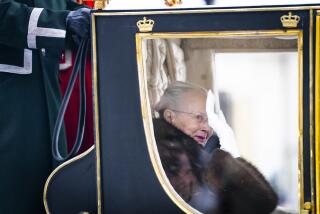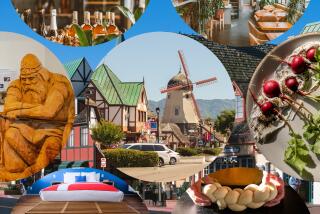Copenhagen Gets a Cosmopolitan Face-Lift
- Share via
COPENHAGEN — It was long seen as the capital of a fairy-tale nation, known mostly for its Little Mermaid statue, twinkling Tivoli amusement park and picturesque old waterfront. But Copenhagen is shedding its past for a more technological future.
In the past decade, it has undergone a dizzying face-lift in transforming itself from a city on Europe’s periphery to a regional business and transportation center.
The modernization -- which has cost $15 billion so far -- includes dozens of glass-and-steel office buildings, a bridge-and-tunnel link to southern Sweden, huge shopping malls and new hotels in the city of 1.8 million people.
Two new terminals and a train connection have been added at Copenhagen’s international airport, a regional hub through which 18.3 million passengers traveled last year.
In May, Queen Margrethe II, the popular figurehead monarch, opened a new extension of the driverless subway system, the Metro, that began operations in October.
Large-scale demolitions and restoration work have swept over downtown working-class neighborhoods since the early 1990s, and a former navy base became an arts campus.
“We have gone from a somewhat dusty and dull city to a modern, dynamic city,” said Rolf Larssen at Copenhagen Capacity, an agency working to attract foreign companies.
He exaggerates about the past.
Copenhagen once was an international jazz capital. And the city remains a haven for individuality, particularly in Christiania, a hippie enclave created at an abandoned military barracks in 1971 by a handful of flower-power Danes advocating nudity, free marijuana, no authorities.
In 1969, the easygoing and liberal-leaning Danes made headlines when parliament legalized pornography and Copenhagen hosted the first ever international sex fair. For years, its famous sex district was crowded with foreigners who visited the adult stores and sneaked into the X-rated cinemas.
Still, few people dispute the city’s transformation.
“It used to be a provincial kind of city. Now it has a more international image,” said Leif Livjaegergaard, who has driven a cab for 25 years. “My customers include more businessmen in suits speaking a foreign language than before.”
The city’s population has grown by 100,000 since the early 1990s, including an influx of immigrants from the Middle East and Asia. Downtown districts blossom with signs in dozens of languages, and the spicy aromas of ethnic dishes spill from restaurants.
About 7% of Denmark’s 5.3 million residents are of foreign descent, and Islam has become the Scandinavian country’s second-largest religion after Lutheranism.
Once-popular dim saloons serving beer and stale coffee increasingly are going out of business because people prefer to meet over a latte or macchiato at French-style cafes or American-style coffee shops.
The restaurants at Nyhavn, the picturesque old harbor with multicolored houses and wooden schooners, are getting stiff competition from chic restaurants across town.
Once known abroad for Danish design -- timeless furniture, lamps in clear colors and silvery utensils of simple elegance -- Copenhagen became a fashion center in the mid-1990s. Foreign buyers began flocking to busy catwalks to see creations by home-grown fashion houses Bruuns Bazar, House of Sand and Munthe plus Simonsen.
The most important change could be the city’s growing role in trade.
Copenhagen has become “a crossroad between the Nordic and Baltic countries and the rest of Europe,” said Christian Wichmann Mathiessen, a professor in urban geography.
With Nordic neighbors Sweden and Finland joining it in the European Union in 1995, Denmark found itself in the central role of linking the north with the nations to the south. The Oresund bridge between Malmoe, Sweden, and Copenhagen, which opened in 2000, solidified that role by providing southern Sweden with its first direct land link to continental Europe.
The entry of 10 more nations into the EU by next year, including the Baltic countries of Estonia, Latvia, Lithuania and Poland, is expected to be a further boost for the city.
Copenhagen’s $2-billion subway -- twice as expensive as initially planned -- is intended to help ease increasingly severe traffic jams and the parking shortage.
More to Read
Sign up for Essential California
The most important California stories and recommendations in your inbox every morning.
You may occasionally receive promotional content from the Los Angeles Times.













